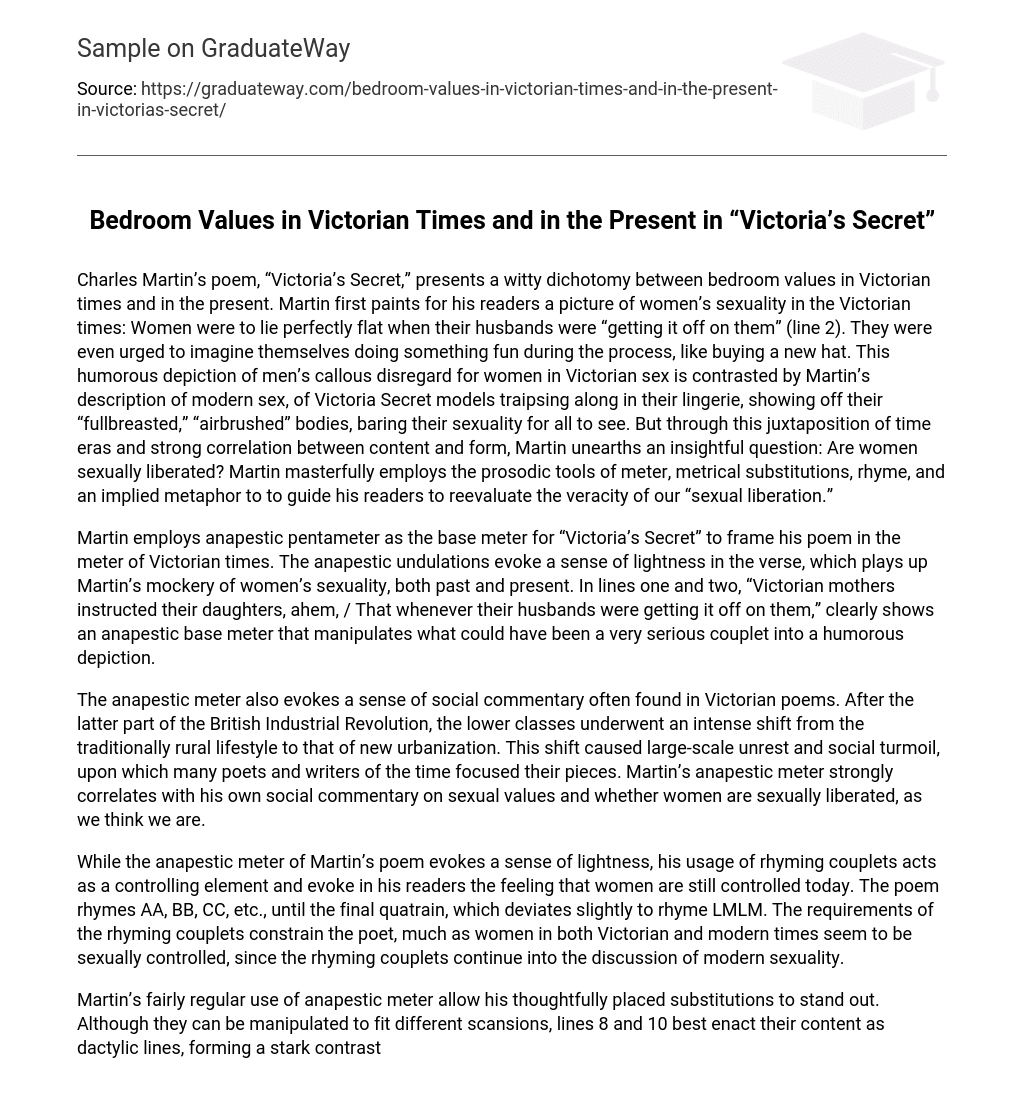Charles Martin’s poem, “Victoria’s Secret,” presents a witty dichotomy between bedroom values in Victorian times and in the present. Martin first paints for his readers a picture of women’s sexuality in the Victorian times: Women were to lie perfectly flat when their husbands were “getting it off on them” (line 2). They were even urged to imagine themselves doing something fun during the process, like buying a new hat. This humorous depiction of men’s callous disregard for women in Victorian sex is contrasted by Martin’s description of modern sex, of Victoria Secret models traipsing along in their lingerie, showing off their “fullbreasted,” “airbrushed” bodies, baring their sexuality for all to see. But through this juxtaposition of time eras and strong correlation between content and form, Martin unearths an insightful question: Are women sexually liberated? Martin masterfully employs the prosodic tools of meter, metrical substitutions, rhyme, and an implied metaphor to to guide his readers to reevaluate the veracity of our “sexual liberation.”
Martin employs anapestic pentameter as the base meter for “Victoria’s Secret” to frame his poem in the meter of Victorian times. The anapestic undulations evoke a sense of lightness in the verse, which plays up Martin’s mockery of women’s sexuality, both past and present. In lines one and two, “Victorian mothers instructed their daughters, ahem, / That whenever their husbands were getting it off on them,” clearly shows an anapestic base meter that manipulates what could have been a very serious couplet into a humorous depiction.
The anapestic meter also evokes a sense of social commentary often found in Victorian poems. After the latter part of the British Industrial Revolution, the lower classes underwent an intense shift from the traditionally rural lifestyle to that of new urbanization. This shift caused large-scale unrest and social turmoil, upon which many poets and writers of the time focused their pieces. Martin’s anapestic meter strongly correlates with his own social commentary on sexual values and whether women are sexually liberated, as we think we are.
While the anapestic meter of Martin’s poem evokes a sense of lightness, his usage of rhyming couplets acts as a controlling element and evoke in his readers the feeling that women are still controlled today. The poem rhymes AA, BB, CC, etc., until the final quatrain, which deviates slightly to rhyme LMLM. The requirements of the rhyming couplets constrain the poet, much as women in both Victorian and modern times seem to be sexually controlled, since the rhyming couplets continue into the discussion of modern sexuality.
Martin’s fairly regular use of anapestic meter allow his thoughtfully placed substitutions to stand out. Although they can be manipulated to fit different scansions, lines 8 and 10 best enact their content as dactylic lines, forming a stark contrast with the anapestic lines surrounding them:
Over her thrashing and thrusting until he was spent.
Or so we imagine, persuaded that our ancestors
Couldn’t have been as free from repression as we are,
The dactylic meter of line 8 not only evokes the motions of thrashing and thrusting, but is also one of the first disruptions in the poem’s meter. This allows the line to stand out—to emphasize that sex in Victorian times was not only for the man’s pleasure, but was commonly painful for women. Women were merely used for sex. Line 10 also stands out as a break from the base meter in emphasis of one of Martin’s first hint that modern women are not sexually freer than the women of Victorian times, as we think we are.
Martin again disrupts his base meter in the last three lines, which are scanned as iambic pentameter:
That never close and in their depths lie frozen
The wordless dreams shared by all merchandise,
Even the hats that lie in the dark to be chosen.
The these last lines scan as though they could fit a modern poem. Martin uses this break from base meter to emphasize the idea that women as sexual objects is as prominent in present time (iambic pentameter) as it was in Victorian times (anapestic pentameter). The very last line is composed of both iambs and anapests. In bringing together the meter of two eras, the poet implies that women’s sexuality in Victorian times and now is much the
same, and hasn’t changed as we would like to think it has.
Finally, Martin uses an implied metaphor, comparing women to merchandise, to bring the whole poem together. The poem describes modern women as “fullbreasted” and “airbrushed” and refers to them as images on the pages of a Victoria’s Secret catalogue. Not as humans, but as objects available for men to buy and use. Martin goes even further and connects the original image of Victorian women imagining that they are buying hats during sex in the last line. He states that dreams are shared by all merchandise (women), “[e]ven the hats that lie in the dark to be chosen.” Through this line, Martin evokes the sense that women of both Victorian times and present are merely sexual objects, an idea that was enacted throughout the poem through Martin’s masterful use of Victorian framed meter, emphatic metrical substitutions, and controlling rhyme scheme.





